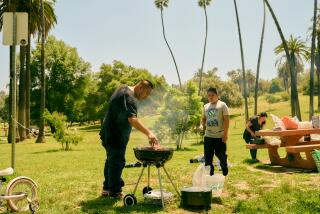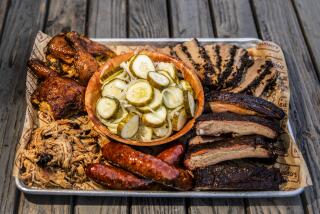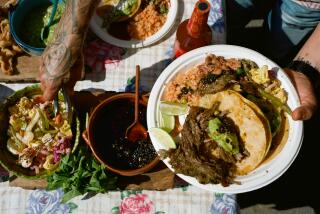Safety Tips for Summer’s Grill Chefs
- Share via
NEW YORK — Shove over, pedestrian hamburgers and hot dogs. Everything goes on the grill these days, from fish to vegetables to pizza to dessert.
Grilled food tastes great, makes great summer sense and helps guarantee a great party. And starting with this holiday weekend, you’re likely to be charmed by odors from neighbors’ back-yard barbecues.
Unfortunately, grilling may not always be a completely safe way of cooking.
When fat from meat or fish drips onto coals, a flame or a heating element, chemicals form that are suspected carcinogens. Those chemicals rise with the smoke and can land on the food. Possibly harmful chemicals also are formed when meat is charred.
It sounds ominous, but there are ways to significantly reduce the risk, and experts say there’s no need to avoid the grill.
“Clearly that’s not going to happen even if we said to,” said Dr. Daniel Nixon, an American Cancer Society spokesman. “It’s certainly not anything like smoking cigarettes or eating a high-fat diet.”
Precooking meat helps, he said. Baking, boiling or cooking meat or fish in a microwave oven about halfway reduces the time the food spends on the grill and gets rid of some of the fat. Use the grill to finish the cooking, reducing time to compensate for the initial cooking.
However, this should not be done with food being brought to a park or beach, because bacteria will grow on the meat and possibly cause illness.
Another option is to grill less meat and fish, because it’s the dripping animal fat that’s of concern. Try vegetables, fruit or pizza--all very popular grill items these days both at home and in restaurants.
Back-yard grilling became popular after World War II, when droves of people moved to the suburbs and wanted to show off their new yards. The first home grill appeared around 1946, Kelly McCune writes in the “Grill Book.”
“In the last decade, grilling has become the quintessential cooking technique in this country,” with influences as wide-ranging as Kansas City classic barbecue and Asian marinades, say David Barich and Thomas Ingalls in “Chicken on the Grill.”
From burgers, franks and chicken, back-yard cooks have branched out to oysters, tuna steaks, marinated tofu, corn on the cob, polenta cakes, garlic bulbs, leeks, sweet potatoes, pineapple slices and bananas.
People who rarely eat grilled foods don’t have much to worry about, but those who fire up the grill regularly should take reasonable precautions. Michael Jacobson, Lisa Lefferts and Anne Witte Garland offer these suggestions in their book, “Safe Food”:
* Keep fat from dripping onto the heat source and producing smoke. Use a drip pan, wrap meat in foil or grill meat so it’s not directly over the coals. Increase the distance between the meat and the heat source.
* Select low-fat cuts of meat, or choose fish, poultry or vegetables for grilling. Trim fat and skin before cooking.
* Keep the oil in marinades to a minimum.
* Avoid charring meat.
* Use regular charcoal. Soft woods burn at a higher temperature and form more of the suspect chemicals than hardwood, from which charcoal is made.
More to Read
Eat your way across L.A.
Get our weekly Tasting Notes newsletter for reviews, news and more.
You may occasionally receive promotional content from the Los Angeles Times.










